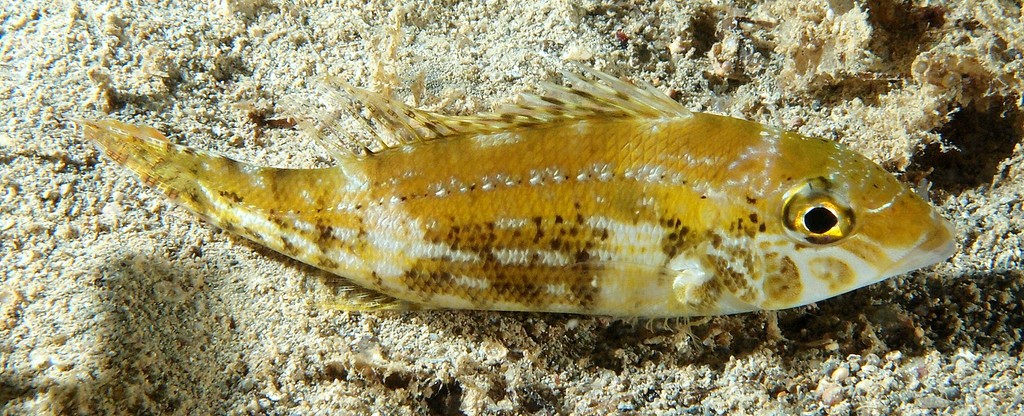LETHRINUS GENIVITTATUS - (VALENCIENNES, 1830)
Actinopterygii (Gigaclass) > Actinopteri (Class) > Teleostei (Subclass) > Acanthuriformes (Order) > Lethrinidae (Family) > Lethrininae (Subfamily) > Lethrinus (Genus)
Lethrinus à joues rayées, Communard, Lance emperor, Large-eye bream, Longspine emperor, Pigface bream, Thread-fin emperor, Threadfin bream, Threadfin bream, Ito-fue-fuki, Ito-fuefuki, イトフエフキ, Chul-gal-dom, 줄갈돔, 線棘裸頰鯛, 龙尖, Cá Hè vằn,
Synonyme
Lethrinus nematacanthus (Bleeker, 1854)
------------------------
Description
Dorsal spines (total): 10; Dorsal soft rays (total): 9; Anal spines: 3; Anal soft rays: 8. Head long slightly less than body depth; Profile slightly humped above eye; Four tusk-like canine teeth at front of mouth, directed backwards at about 45°. Inner base of pectoral fin scaled; Second dorsal fin spine produced into a filament, contained: 1.2-2.4 in Head Length. Max length: 25.0 cm TL, common length: 15.0 cm TL. Max. reported age: 7 years. Depth range: 5 - 25 m.
Color
Body is tan or brown on the upper sides, white on the lower sides, with three tan or brown stripes. The sides often have scattered irregular black oblique bars and a square black blotch above the pectoral fin and bordering below the lateral line. The head is brown or tan sometimes with several broad, somewhat indistinct vertical and oblique bands (these bands are sometimes composed of fine reticulations). The fins are pale, speckled with small white blotches.
Etymology
Lethrinus: from Greek, lethrinia, a fish pertaining to genus Pagellus (Pagellus erythrinus (Linnaeus, 1758)), a Mediterranean fish looking like Lethrinidae family.
genivittatus: from Latin, gena = lateral part of the face, cheeks + from Latin, vittatus = striped, banded. Referring to large reddish-brown bands sometimes present on cheek.
Original description: Lethrinus genivittatus Valenciennes, 1830 - Type locality: Indian seas.
Distribution
Eastern Indian Ocean and western Pacific: Indonesia, east to Caroline Islands, New Ireland (Papua New Guinea) and Vanuatu, north to Korea and Japan, south to Rottnest Island (Western Australia), Merimbula (New South Wales, Australia) and New Caledonia.
Biology
Solitary or in groups. Occurs over shallow sandy and seagrass beds, in mangrove swamps, lagoons, channels and outer reef slopes. May enter rivers. Feeds on crustaceans and small fishes. A protogynous hermaphrodite. A protracted spawning peak from July to December is recorded in New Caledonia. Smaller and more numerous females than males have been confirmed in Australian populations. Marketed fresh. A monandric species. Length at sex change = 18.0 cm TL.
Last update: 16, October 2024
Lethrinus à joues rayées, Communard, Lance emperor, Large-eye bream, Longspine emperor, Pigface bream, Thread-fin emperor, Threadfin bream, Threadfin bream, Ito-fue-fuki, Ito-fuefuki, イトフエフキ, Chul-gal-dom, 줄갈돔, 線棘裸頰鯛, 龙尖, Cá Hè vằn,
Synonyme
Lethrinus nematacanthus (Bleeker, 1854)
------------------------
Description
Dorsal spines (total): 10; Dorsal soft rays (total): 9; Anal spines: 3; Anal soft rays: 8. Head long slightly less than body depth; Profile slightly humped above eye; Four tusk-like canine teeth at front of mouth, directed backwards at about 45°. Inner base of pectoral fin scaled; Second dorsal fin spine produced into a filament, contained: 1.2-2.4 in Head Length. Max length: 25.0 cm TL, common length: 15.0 cm TL. Max. reported age: 7 years. Depth range: 5 - 25 m.
Color
Body is tan or brown on the upper sides, white on the lower sides, with three tan or brown stripes. The sides often have scattered irregular black oblique bars and a square black blotch above the pectoral fin and bordering below the lateral line. The head is brown or tan sometimes with several broad, somewhat indistinct vertical and oblique bands (these bands are sometimes composed of fine reticulations). The fins are pale, speckled with small white blotches.
Etymology
Lethrinus: from Greek, lethrinia, a fish pertaining to genus Pagellus (Pagellus erythrinus (Linnaeus, 1758)), a Mediterranean fish looking like Lethrinidae family.
genivittatus: from Latin, gena = lateral part of the face, cheeks + from Latin, vittatus = striped, banded. Referring to large reddish-brown bands sometimes present on cheek.
Original description: Lethrinus genivittatus Valenciennes, 1830 - Type locality: Indian seas.
Distribution
Eastern Indian Ocean and western Pacific: Indonesia, east to Caroline Islands, New Ireland (Papua New Guinea) and Vanuatu, north to Korea and Japan, south to Rottnest Island (Western Australia), Merimbula (New South Wales, Australia) and New Caledonia.
Biology
Solitary or in groups. Occurs over shallow sandy and seagrass beds, in mangrove swamps, lagoons, channels and outer reef slopes. May enter rivers. Feeds on crustaceans and small fishes. A protogynous hermaphrodite. A protracted spawning peak from July to December is recorded in New Caledonia. Smaller and more numerous females than males have been confirmed in Australian populations. Marketed fresh. A monandric species. Length at sex change = 18.0 cm TL.
Last update: 16, October 2024
